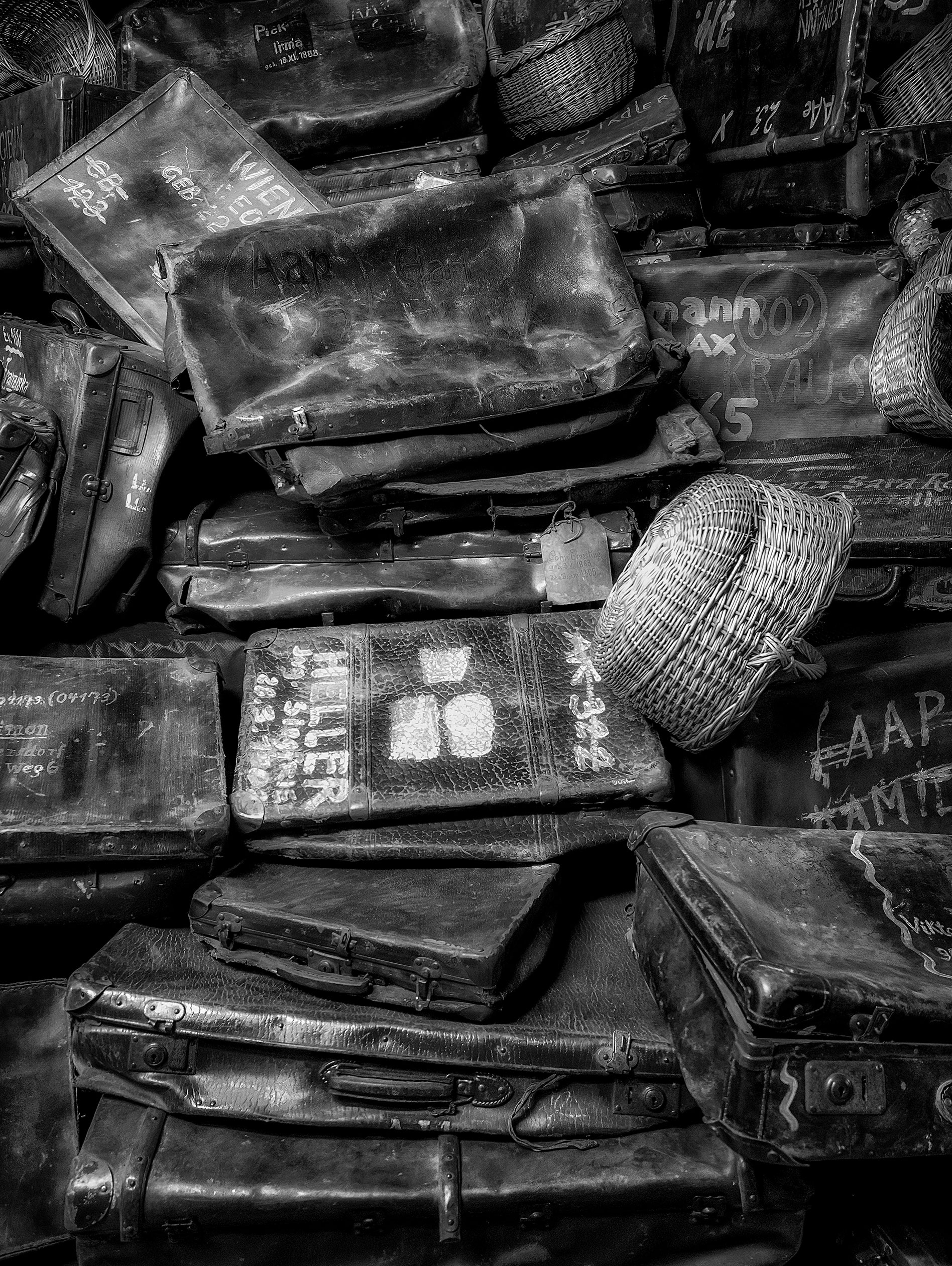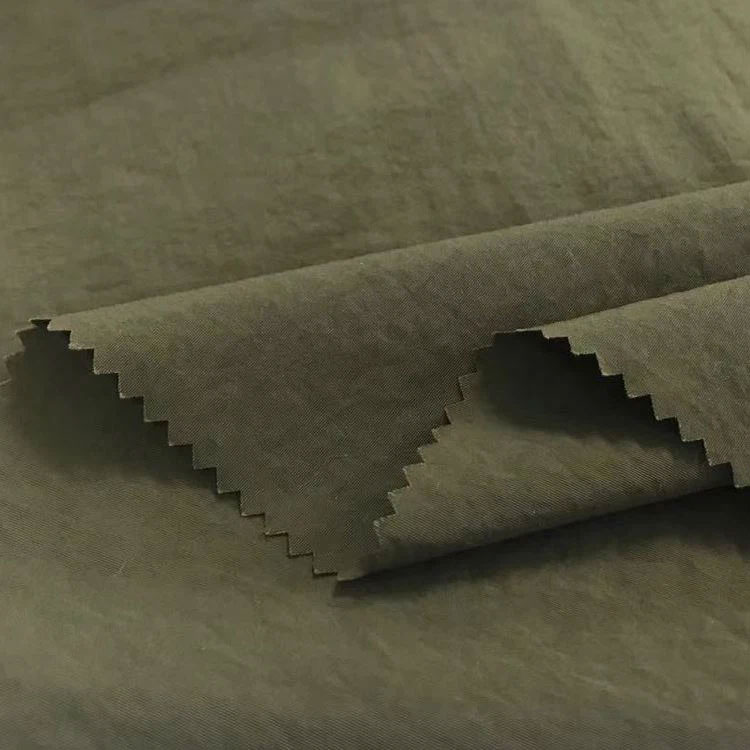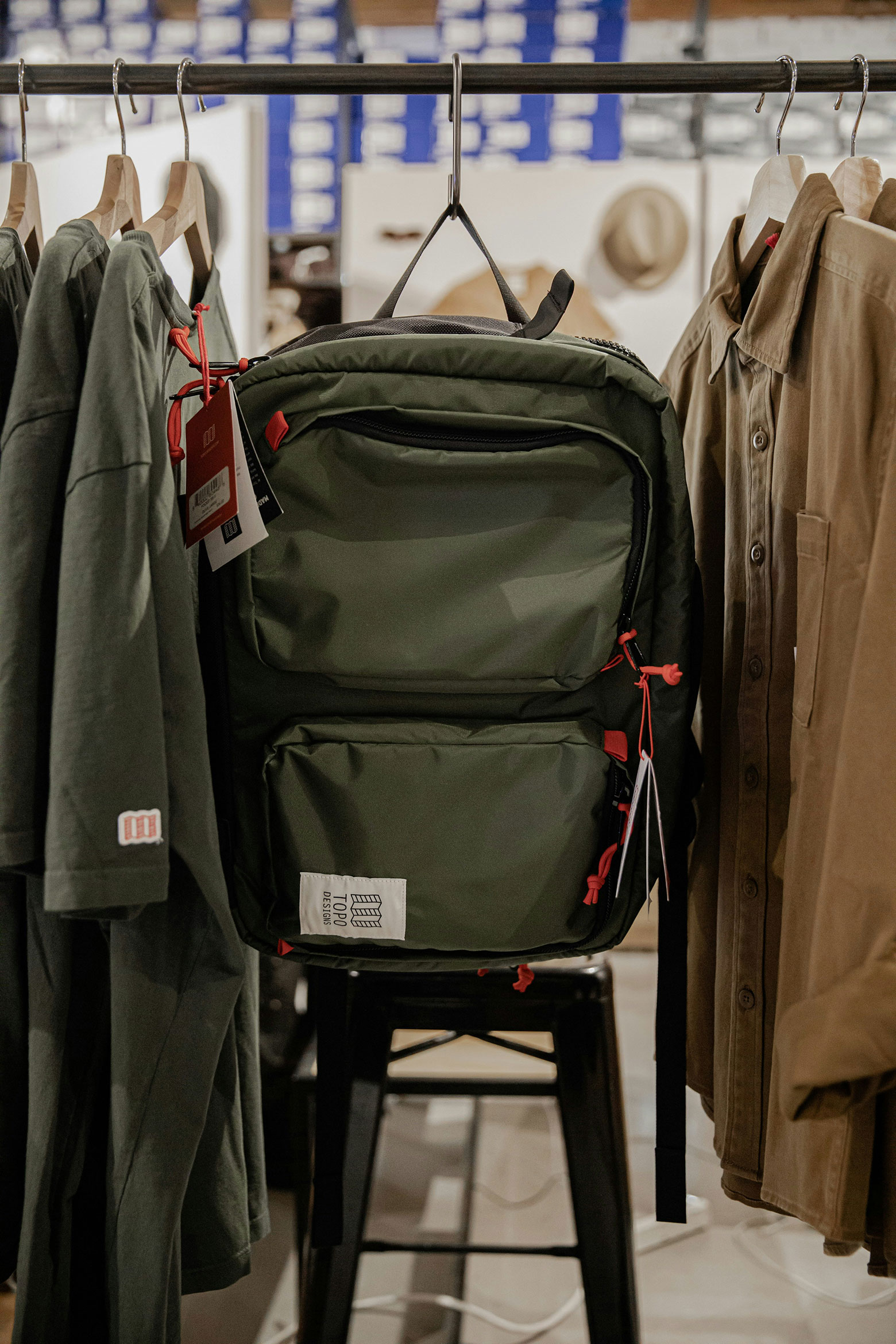A quick look at how bags have changed over 7,000 years: From basic tools to fashion icons.
The history of bags is really the story of how we’ve lived. For over 7,000 years, these things have changed as our world has, showing changes in tech, fashion, what different genders do, and what we care about. From old leather bags that held tools to today’s bags that can charge your phone, how bags have changed tells us a lot about people being smart and how society grows.
At first, bags were just something we needed—a way to carry things while keeping our hands free to hunt, collect stuff, and stay alive. Now, they’re a huge part of fashion that people care a lot about. Some luxury bags cost more than whole estates did way back when, but they still do the same job as those old animal skin bags: keep our stuff safe and easy to get to.
Let’s walk through how bags have changed over time, seeing how big events, new tech, and changes in society shaped the things we can’t live without today.
Way Back When: The Start of Portable Storage (5000 BC – 500 AD)
The Iceman’s Find: The First Bag Ever?
The oldest bag we know of is from about 5000 BC (just to give you an idea, the ancient Egyptian thing started around 3100 BC). They found the first proof of a bag when they found Otzi the Iceman, the oldest mummy in Europe, back in 1991.
Finding Ötzi changed what we thought about old bags. This guy, who lived 5,300 years ago and was found frozen in the Alps, had a cool leather bag with flint, tinder, and herbs for medicine. How the bag was made showed they knew a lot about working with leather, and that even way back then, having a way to carry stuff was seen as key to survival.
Old Civilizations and Special Pouches
Bags go way back, with early people using simple pouches made from animal skins to carry important things. Ancient Egyptians made bag-making into an art, with fancy bags made of leather, linen, and expensive metals. These weren’t just useful—they were kind of spiritual, often holding charms, coins for the afterlife, and holy writings.
Roman soldiers had leather bags called loculus for their stuff, writing tools, and food. These bags had good ways to close and keep water out, which affected how bags were made for a long time. The Romans also came up with the first bag strings, using drawstrings that are still popular today.
Greek pottery often shows people carrying different kinds of bags, from simple cloth bags to fancy leather ones with bronze stuff on them. These pictures show that bags were already a way to show off your status and style.
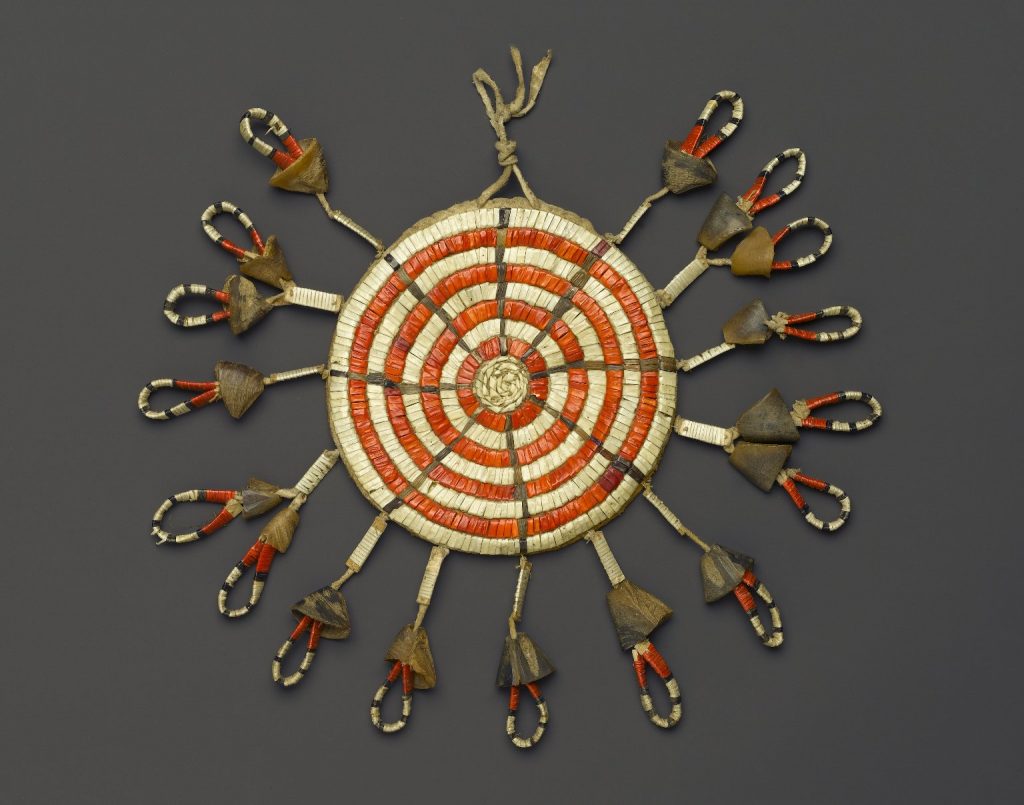
Pouch, Arapaho (Native American), late 19th or early 20th century, Brooklyn Museum
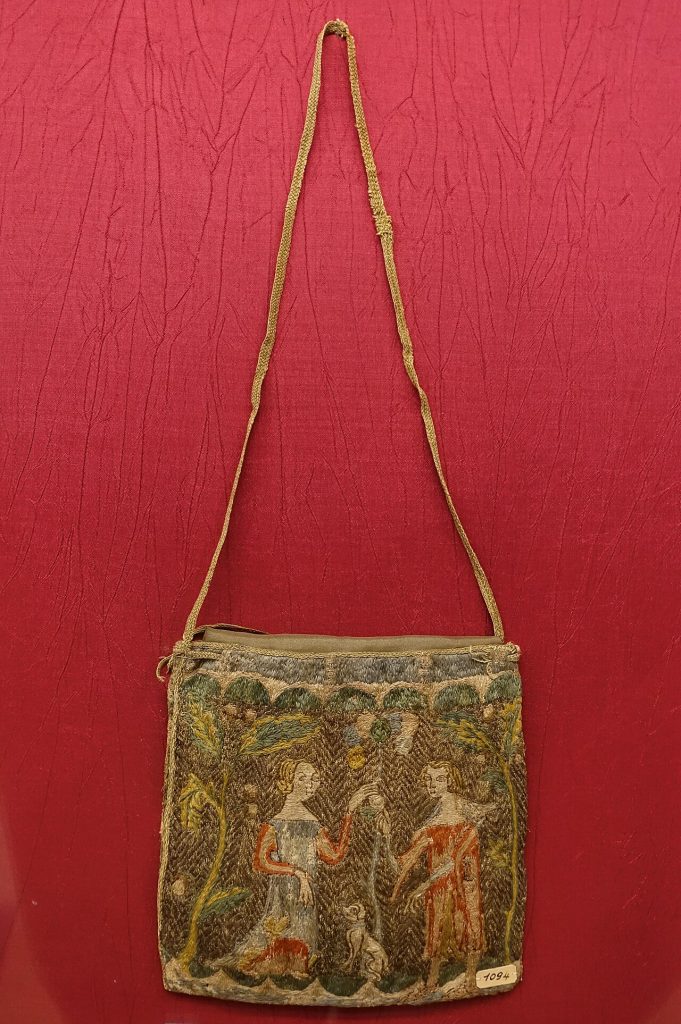
Embroidered purse, France, mid 14th century AD
sc: via wikipedia.org
Medieval Times: Bags for Different Jobs
In the medieval times, bags started to be made for different uses. Pilgrims had special bags called scrips—leather pouches that showed they were travelers for their religion and held their few things. These bags were often blessed and seen as holy.
From the 12th to the 16th century, people carried things in a leather bag with a drawstring. There was also the ‘Chatelaine’—a chain people wore around their waist to carry keys and tools. It came back in the 1840s to hold scissors, measuring tapes, and sewing gear.
The chatelaine is one of the coolest bag ideas ever. Rich women in medieval times wore these chain things that held everything from keys to perfume and sewing stuff. It was useful and looked good, showing everyone that the woman was in charge of her home and had a high social position.
Renaissance Time: Bags Show Off Wealth (1400-1700)
The Pocket Problem and Guys vs. Girls
Back then, people used bags like we do now—to carry their everyday stuff. Clothes didn’t have pockets until the 17th century, so guys also carried bags for things like coins and religious items. One buckle bag from the 16th century, worn on a belt, had 18 secret spots.
The Renaissance was a big time for bags. As clothes started to fit better, people needed ways to carry more stuff. Rich people carried fancy bags to show off their money, using expensive materials, detailed designs, and hard-to-open locks.
When pockets were added to guys’ clothes in the 17th century, it created a split between what guys and girls did in fashion. Guys could use pockets, but girls’ fashion got tighter, so they needed bags more than ever. This change affected bags for years.
Art and Fancy Materials
Renaissance bags were like art from that time. Italian people made leather bags that were as good as paintings. These bags had:
Good Metal Work: Bronze and silver pieces with detailed designs and religious symbols
Fancy Fabrics: Silk inside, velvet outside, and gold designs
Good Locks: Locks that took many steps to open and secret places for important items
Custom Designs: Family symbols and special initials
This was when the idea of a designer bag was born, with some bag makers becoming famous for their work. Rich people ordered bags like they ordered paintings, getting special bags that showed off what they liked and who they were.
The Industrial Age: Bags for Everyone (1700-1900)
18th Century: The Little Bag Time
In the 18th century, the modern bag was born with the reticule—small, pretty bags that women carried when their clothes didn’t have pockets. Made of silk or cotton, these bags matched outfits and were the first real fashion bags.
Reticules did more than just carry things. They were things to talk about, gifts between people who liked each other, and symbols of being a woman. They were often made by the women who carried them, showing off skills like needlework that people valued in women back then.
Industrial Revolution: Tech Meets Fashion
The Industrial Revolution changed how bags were made with machines and new materials. Machines powered by steam made leather better, and new metals made stronger bag parts. New chemicals made bright colors possible.
Traveling by train made people want special bags for travel, leading to bags with strong corners and frames. These ideas later affected bag design, making bags stronger and able to handle weather, which is still important today.
19th Century: The Modern Bag Arrives
Bags changed a lot in the early 1900s as women started going out more. That’s when the word handbag started to be used. The bags we see now were based on the useful, almost suitcase-like bags that women carried back then.
The 19th century set the stage for modern bags with some key changes:
The Carpet Bag: Made from carpet, these bags were strong and had cool designs
The Chatelaine Comeback: People started using it again in the 1840s to hold sewing stuff
Frame Bags: Metal frames made bags strong and easy to close
Travel Gear: As travel got popular, people wanted travel bags that were useful and safe
As people started moving around more, they needed bags that could be used in different places. Women wanted bags for visiting friends, shopping, and going out at night—leading to different bags for different times, which is still how fashion works today.
The 20th Century: Fashion Goes Wild (1900-2000)
Early 1900s: The Start of Handbag Culture
Bags changed a lot in the early 1900s as women started going out more. That’s when the word handbag started to be used. Society started to see women and their bags differently.
The women’s rights movement affected bag design. Women wanted bags that showed they were good at their jobs and knew what they were doing, but still looked good. This led to bags with simple designs, strong parts, and places to keep things organized.
The Roaring Twenties: Fun and Fashion
In the 1920s, bags became more about fashion than just being useful. Art Deco styles brought designs and colors that matched the wild fashion of the time. Beaded bags were key for going to parties and dances.
This was also when bags started matching other things. Bags matched shoes, hats, and gloves, creating the idea of a complete look that affected fashion for years.
The Depression and World War II: Usefulness First
During the hard times of the 1930s and 1940s, bags had to be strong and useful instead of just pretty. Materials were limited, leading to new ways to use different fabrics and simple designs that were as useful as possible.
But bags were still important to people. Even when times were tough, women found ways to have stylish bags, often fixing them and making them last longer.
After the War: The Good Times of Design
The 20th century saw a big change in bag design, affected by culture, fashion, and tech. In the early years, some famous bags came out that are still popular today. In 1929, Coco Chanel made the Chanel 2.55, which changed how women saw luxury bags.
The 1950s and 1960s were the best time for bag design. After the war, people had more money, and society was changing. Some key things happened:
Coco Chanel’s Game Changer: The 2.55 bag was both useful and fancy, with leather, chain straps, and a good lock
New Designs: New materials made bags with new shapes and better strength
Lots of Colors: New chemicals made bright colors that weren’t possible before
World Influence: Travel let designers see new styles from other cultures
The Sixties: Young People Rebel
In the 1960s, young people changed things, and that included bags. Bags became a way to show who you were. Regular bags were replaced by shoulder bags, colorful designs from other cultures, and new materials like plastic.
This was when bags started to be tied to music. Different music scenes had different bag styles, showing how bags could represent culture.
1970s-1980s: Designer Names and Showing Off
In the late 20th century, designer bags became the ultimate way to show off. Brands like Louis Vuitton, Hermès, and Gucci went from being bag makers to big luxury brands, making bags that were like wearing money.
Some things that make luxury bags what they are today came from this time.
- Limited Stuff: Making people want things because they’re hard to get
- Brand Names: Showing off a brand name to show status
- Famous People: Using famous people to make people want bags
- Money Value: Bags that can become more valuable over time
The Digital Age: Tech Meets Old Ways (2000-Now)
New Tech: Smart Bags and Green Luxury
The new century brought tech to bag design. Modern bags have things our grandparents couldn’t have imagined:
Cool Tech:
- Spots to charge phones
- GPS to find your bag if it’s stolen
- Lights inside so you can see
- Bluetooth to connect to your phone
Green Materials:
- Plastic from recycled sources and materials that used to be something else
- Fake leather made from leaves and mushrooms
- Ways to make bags with no waste
- Ways to make bags that don’t hurt the environment
Making it Your Own:
- Ways to print 3D things to put on your bag
- Ways to print any design you want
- Ways to change parts of your bag
- AI that helps you pick the best bag for you
The Louis Vuitton Story: Skill Meets New Ideas
Louis Vuitton Malletier SAS, or Louis Vuitton, is a French luxury company started in 1854 by Louis Vuitton. The LV symbol is on most of its stuff, from bags to clothes, shoes, perfumes, watches, and books. Louis Vuitton is one of the biggest luxury brands.
How Louis Vuitton went from making trunks to being a world leader shows how bag making has changed. Whether you like the brand’s bags with the logo all over them or not, Louis Vuitton is the biggest bag brand.
The brand’s success shows how old skills can work with new ideas while keeping the brand’s history. Today’s Louis Vuitton bags, like the Neverfull tote, are for everyday use, mixing old skills with new usefulness.
Social Media and Bag Culture
Instagram, TikTok, and other places have changed how bags are sold, found, and seen. Social media made:
Influencers: Regular people who become style leaders because of the bags they pick
Quick Trends: Bags that go viral and become popular fast
Easier to Reach: Luxury brands that are easier to talk to through social media
Communities: Bag fans who connect with each other
Real vs. Fake: Ways to prove bags are real and not fake
Selling Again: Places to sell bags and keep their value
Renting: Ways to use luxury bags without buying them
What Bags Mean to Us: How They Show What We Care About
Guys, Girls, and Showing Who You Are
Over time, bags have shown and changed how we see men and women, status, and who we are. They’ve gone from useful bags to ways to show off fashion, showing how we see ourselves and what’s important to us.
Work Life: Bags that show you’re good at your job
Money Status: Luxury bags that show you have money
Culture: Bags that keep old cultural styles alive
Yourself: Bags that show who you are and what you like
Why We Like Bags
Psychologists know that people get attached to their bags. These relationships involve:
Safety: Bags that make you feel safe because you have everything you need
Showing Yourself: Picking a bag that shows your personality
Memories: Bags that remind you of good times
Showing Your Status: Picking a bag that shows what group you’re in
Bags Around the World
European Skills
European bags focus on good skills, great materials, and styles that last. Countries like Italy, France, and England have styles that still affect fashion today:
Italian Best: Focus on good leather and strong designs
French Style: Focus on pretty designs and luxury
British Ways: Classic styles that are strong and useful
Asian Creativity and Making
Asian countries are now both making and designing bags:
Japanese Style: Simple style and well-made bags
Korean Style: Korean fashion that changes the world
Chinese Making: Good making that makes bags easy to get
American Usefulness and New Ideas
American bags focus on being useful and having new tech:
Outdoor Life: Bags for being active
Work Life: Bags for being good at your job
Tech Life: Bags with cool tech
The Money of Bags: From Making to Business
How the Market Works
The bag market has gone from small shops to a huge business that affects fashion and money. Knowing how this happened shows how customers, making, and marketing have shaped bag culture.
Market Size:
- The world’s luxury bag market is more than $50 billion each year
- Cheap bags make luxury styles easy to get
- Old bags and vintage bags are a green way to buy
- Renting bags lets you use luxury bags without buying them
Types of Customers:
- Super Luxury: Special bags that are hard to get
- Easy to Get Luxury: Good brands that are easier to get
- Cheap Fashion: Trendy bags that are cheap
- Green Choices: Good for the earth and getting more popular
How Bags are Made and Sold
Making bags now involves a big system that connects people who sell materials, make bags, and sell them. This system makes both luxury bags and cheap bags easy to get, but it also raises questions about how people are treated, how it affects the earth, and if it’s real.
Keeping Old Skills Alive:
- Italian leather skills passed down for years
- French luxury brands keeping old making ways alive
- People making bags the old way to keep traditions alive
- Big brands balancing old ways with new ways
Using Tech:
- Using computers to make designs
- Using machines to cut materials better
- Checking to make sure bags are good
- Tracking where materials come from to make sure they’re real
The Earth and Bags: What’s Next?
Green Bags
The fashion business hurts the earth, so people want green bag options. People now think about the earth when they pick bags.
Green Materials:
- Plant Stuff: Fake leather from leaves, mushrooms, and apples
- Recycled Stuff: Bags from plastic from the ocean and recycled clothes
- No Waste: Products made to be taken apart, fixed, and used again
- Local Stuff: Getting materials from nearby to save on travel
Making Things Better:
- Saving Water: Using less water to make leather
- Saving Energy: Using green energy to make bags
- Less Waste: Using all materials when making bags
- Safe Chemicals: Using safe chemicals to make bags
What’s Next for Bags
New tech and changing society will change how bags are made:
Smarter Bags:
- Scanners: Scanning your fingerprints and face to open your bag
- Health Tracking: Feeling how you stand and move
- Weather Changes: Materials that change with the weather
- AI Helper: AI that helps you keep your bag organized
Social and Cultural Changes:
- For Everyone: Designs that work for everyone
- Easy to Use: Bags that are easy for anyone to use
- Mix of Cultures: New styles that mix different cultures
- Special Uses: Bags for specific things you like to do
Bags as Art: Why We Keep Them
Keeping Old Bags Alive
Museums know that bags are important to culture and history, so they keep old bags safe. These places show how bags reflect big changes in society and art.
Good Museum Collections:
- Victoria and Albert Museum ( London ): Big collection of designs from over the years
- Fashion Institute of Technology Museum ( New York ): Focus on new ideas from the 20th century
- Musée des Arts Décoratifs ( Paris ): Focus on French luxury old traditions
- Kyoto Costume Institute: Asian designs and what they mean to the culture
Problems with Keeping Bags Safe:
- Materials Breaking Down: Leather and fabrics that need special care
- Keeping Records: Writing down how bags were made and what they mean
- Letting People See Bags: Letting people see bags without breaking them
- Proving They’re Real: Making sure old bags are real and not copies
Selling and Collecting Private Bags
Old bags have become a good investment, with some bags becoming more valuable than regular investments. This shows that bags are important and creates new problems with proving they’re real and keeping them safe.
What to Think About When Investing:
- How Rare: What makes a bag special and where it came from
- What Condition: How good it looks and if it was fixed
- What’s Popular: What people like and how culture affects value
- How to Store: Keeping bags in the right place to protect them
Bags: Special Examples Around the World
Mediterranean Ways
Mediterranean countries have bag styles affected by boats, farming, and art:
Italian Leather:
Italian leather is one of the best bag materials ever. People in Italy have been making leather for years, making leather that gets better as it gets older. Italian bag makers focus on strong bags, good materials, and styles that last.
Spanish Bags
Spanish bags use designs influenced by Moorish culture, creating designs and good locks. Traditional Spanish bags are strong and practical, showing the country’s history with farming and horses.
Scandinavian Style
Nordic countries have bags that are useful, strong, and simple:
Danish Ideas:
Danish bags focus on simple lines, good features, and green materials. They show how Scandinavian designs focus on quality and taking care of the earth.
Swedish New Ideas:
Swedish brands have made new ways to make green bags, using fake leather and using materials again.
African Styles
African bags mix old ways with new designs, creating styles:
Old Styles:
- Beadwork: Cool designs with meaning
- Natural Stuff: Plant materials and animal skins
- What They Mean: Designs that show who you are
- Useful Designs: Bags that work in different climates
New Styles:
Modern African designers are making brands that are famous around the world while still using old ways. These designers focus on making things fairly, being real, and helping the community.
Why Bags Matter
How We Feel About Bags
We see bags as more than just to carry things. They’re a way we remember, show who we are, and what we want. They show why bags are still a big deal.
Memories:
- Big Moments: Bags from graduations, first jobs, and special days
- Family Heirlooms: Bags that tell stories
- Travel Bags: Bags that remember the places you’ve been
- Daily Bags: Bags that give you comfort
Showing Who You Are:
- Work Bags: Bags that show you’re good at your job
- Style Bags: Bags that show what you like
- Group Bags: Bags that show what group you belong to
- Dream Bags: Bags that show what you want
The Ritual of Bags
Picking, organizing, and carrying a bag is a process that shows what we care about. It shows how bags are a big part of our lives.
What We Think About:
- What We Need: What you want to carry and what you’ll do that day
- Who You’ll See: Picking a bag that fits the situation
- How You Feel: Picking a bag that makes you feel good
- What’s Important: Looking at the weather
Today’s Bag Problems
Keeping Bags Safe
Today’s bags have to solve safety problems that people in the past didn’t have. Digital devices, payment methods, and IDs need new ways to keep them safe.
Making Bags Safe:
- Stopping RFID: Keeping people from scanning your credit cards
- Strong Materials: Stopping people from cutting your bag
- Good Locks: Locks that are both safe and easy to use
- Tracker: Systems to find your bag if it’s stolen
Digital Ways:
- Spots to Protect: Special spots to keep devices safe
- Charging: Built-in ways to charge devices
- Keeping Wires Together: Ways to keep wires from tangling
- Connecting: Ways to connect your bag to devices
Everyone Together
Bags are now being made to fit everyone, no matter what they need.
Bags for Old People:
- Easy to Hold: Designs that are easy to hold
- See Well: High-contrast colors and designs
- Easy to Hold: Ways to make bags easier to hold
- Easy to Reach: Easy to open and close
Bags for Everyone:
- Work for All: Designs that work for everyone
- Useful: Focusing on what’s useful.
Bags and the World
Old Brands
Old brands are still growing while keeping their style. They balance their history with new ideas.
Louis Vuitton:
Louis Vuitton is still the biggest bag brand, showing how brands can stay on top. The company’s success with new ideas and styles shows how old ways can work with new lives.
Old Brand Tactics:
- Good Skills: Showing off old skills and good materials
- Limited Things: Making people want things by making them hard to get
- Cool Friends: Working with artists to stay good
- Green Ideas: Being good to the earth without losing luxury
New Brands
New companies are changing old views. They often focus on different things.
Talking to You:
- Saving Money: Not selling in stores to save money
- Being Direct: talking to customers to get feedback
- Being Flexible: Changing fast to fit trends
- Being Honest: Talking about how bags are made.
Green Leaders:
- New Materials: Finding green materials to make bags
- Using Materials again: Making bags that can be fixed and used again
- Being Fair: Treating workers well
- Transparency: Talking about how they affect the world.
What Bags will Be
New Tech
New tech will add to bag design that makes bags more useful, all raising questions about privacy and people.
What We Think is Coming:
- AI Bags: Bags that learn what you like and keep things organized
- Scanners: Opening bags using your fingerprint
- Weather Bags: Changing the materials based on the weather
- Health Tracking: Bags that track how you move and feel
What We Hope to Fix:
- Keeping Things Private: Protecting information
The Future
What’s been happening can change bags in good ways.
Working From Home:
- Home Work: Bags that make it easy to work
- Techy Bags: Bags that care for the tech
- Comforts: Bags that care for your use for it and make it easy to work
- Many Uses: Bags that can do many different things
Kindness:
- Long Design: Products build for a long term use.
- Can Fix Easy: Designs for maintenance and replacement parts.
- Good Materials: New materials that could be sustainable.
- Close Business: Less travelling through making the business
Final Words: The Enduring Legacy of Human
The seven-thousand years has been changing. The bags will be better for you.
what the bags tell you will be about to change, you can know about cultural. They have been a tools and art for us and has been changed for us.
For now you would know we had been changed everything. You could be a part Louis Vuitton brand there now, you can connect to a industry. Make a new sustainable , smart,and social for all brands.
When we were looking for the bags now, there been a change through those leather pouches in the past.
The part that been use daily and the select to carry for your daily adventures, and be new a design for our long term. You could be the use the same to continue to carry for your belonging for all parts.
#BagHistory #HandbagEvolution #FashionHistory#LouisVuitton#LuxuryBags#SustainableFashion#CraftmanshipHeritage#BagCulture #FashionTimeline #DesignHistory #LuxuryHeritage #BagCollection #VintageBags #FashionEvolution#CulturalHistory #ArtisanCrafts #FashionArchives#BagDesign #LuxuryIndustry #FashionLegacy
